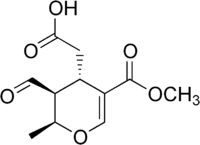Elenolic acid
Elenolic acid is a component of olive oil, olive infusion and olive leaf extract. It can be considered as a marker for maturation of olives.[1]
 | |
| Names | |
|---|---|
| IUPAC name
2-[(2S,3S,4S)-3-formyl-5-methoxycarbonyl-2-methyl-3, 4-dihydro-2H-pyran-4-yl]acetic acid | |
| Identifiers | |
3D model (JSmol) |
|
| ChemSpider | |
PubChem CID |
|
| UNII | |
CompTox Dashboard (EPA) |
|
| |
| |
| Properties | |
| C11H14O6 | |
| Molar mass | 242.227 g·mol−1 |
| Density | 1.308 g/mL |
| Boiling point | 408.9 °C (768.0 °F; 682.0 K) |
Except where otherwise noted, data are given for materials in their standard state (at 25 °C [77 °F], 100 kPa). | |
| Infobox references | |
Oleuropein, a chemical compound found in olive leaf from the olive tree, together with other closely related compounds such as 10-hydroxyoleuropein, ligstroside and 10-hydroxyligstroside, are tyrosol esters of elenolic acid.
References
- Esti, M; Cinquanta, L; La Notte, E (1998). "Phenolic Compounds in Different Olive Varieties". Journal of Agricultural and Food Chemistry. 46 (1): 32–35. doi:10.1021/jf970391+. PMID 10554192.
This article is issued from Wikipedia. The text is licensed under Creative Commons - Attribution - Sharealike. Additional terms may apply for the media files.